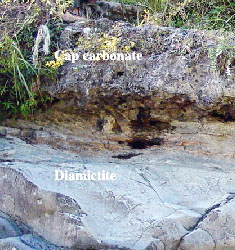
The Earth's most severe ice coverings are thought to have occurred about 600 million years ago, with frozen ice sheets covering much of the globe. Some scientists have suggested the oceans froze over during that time, resulting in a white planet or "snowball Earth" that would have reflected much of the Sun's heat and resulted in a condition of persistent extreme cold.
Now, in a study published in the December 18 issue of the journal Nature, scientists describe new evidence from south China that explains how the planet might have thawed from its icy past. According to geologist Ganqing Jiang of the University of California at Riverside and lead author of the paper, the results point to the release of the powerful "greenhouse gas" methane, than to the release of carbon dioxide, which has been believed to be the mechanism by which the Earth re-warmed.
Where did the methane come from? "It probably arose from deposits known as methane hydrates," said Jiang. "Methane hydrates likely were widespread in sediments deposited under very cold conditions and would have been released as a gas at the end of this ice age, rapidly warming Earth's climate."
Methane hydrates usually are locked away in Earth's sediments, said Herman Zimmerman, director of the National Science Foundation's (NSF) division of earth sciences, which funded the research. NSF is the federal agency responsible for supporting basic science, engineering and education research.
"But large amounts of greenhouse gases may be released from those sediments, during so-called 'destablization events.'" If this hypothesis is correct, added Enriqueta Barrera, geology and paleontology program director at NSF, "this could have been the largest such release of methane in Earth history. This is an important process needing further study, because a similar event could occur in the future as a consequence of global warming."
The new data provide strong support for an idea first published by Jiang's coauthors, geologists Martin Kennedy, also at UC-Riverside, and Nicholas Christie-Blick of Columbia University's Lamont-Doherty Earth Observatory. Features observed in many of the sediments studied seemed to indicate a role for a release of methane from exposed methane hydrates. The new data are based on especially well preserved samples, say the scientists.
"If this study is borne out by further research, it may point to the largest such methane hydrate release in more than four billion years of Earth history," said Jiang. "Such an event would have had a profound impact on global climate."